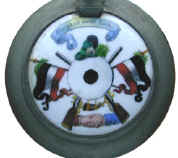|
~ Westerwald Stoneware Relief
(sometimes called "Regensburg")
|
Relief steins such as the one
illustrated in this article are plentiful. Sometimes called Regensburg
steins, it was concluded several years ago that these steins were not
manufactured in that city, and should be referred to as Westerwald.
Common characteristics include a heavy gray body (sometimes found in a brownish
coloration) formed in a three-part mold, a salt-glazed finish, and a
hand-applied handle. The relief designs sometimes lack sharpness, a result of
wear on the mold following repeated use. In addition to their weight and partly
as a result of their lack of color, these steins have a heavy, or sturdy, feel.
It's easy to imagine their being filled with a cold beer, raised in toast in a
dark tavern, and used in slaking many a thirst. The simple strength of these
steins suggests they were inexpensively made, and they should be inexpensive to
acquire today.
The central figure on this stein is King Gambrinus astride a barrel of his
favorite brew. The sides of this example are decorated with entwined ivy vines
and by examining both the outside and the inside of the body it can be seen that
the bottom portion, i.e., that portion below the row of ivy vines, was formed
separately and then applied to the upper body. As a result, this stein is
somewhat larger than expected, having a capacity of 1¼-liters (capacity is not
marked on the stein). The handle was applied at the same time. (Note the
"fingerprint" impression at the base of the handle.)
These steins are commonly found with heavy flat pewter lids, sometimes
containing a relief medallion in the center, or with a porcelain inlaid lid, as
this example.
What factory made these steins? Even if they were made by a single factory, it
is unlikely that we will ever identify the maker. How old are they? This is an
interesting question. Gary Kirsner, in The Beer Stein Book, indicates
that they were made in the late 1800's. But many times these steins are found
with a closed hinge ring (i.e., the so-called "pin" is invisible), and
many are fitted with a ball thumblift mounted over the rim of the lid, both of
which are characteristic of earlier manufacture.

|
|
|

 Stein Collectors International
Stein Collectors International

 Stein Collectors International
Stein Collectors International